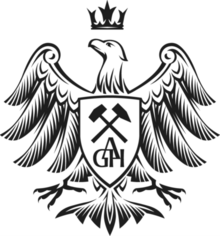AGH University of Science and Technology
| Akademia Górniczo-Hutnicza im. Stanisława Staszica w Krakowie | |
 |
|
| Motto | "Labore creata, labori et scientiae servio" |
|---|---|
|
Motto in English
|
"Born in labour, I serve the labour and science" |
| Type | Public |
| Established | 1919 |
| Rector | Professor Tadeusz Słomka |
|
Academic staff
|
1,964 (30 Nov 2014) |
|
Administrative staff
|
4,233 (30 Nov 2014) |
| Students | 35,531 (30 Nov 2014) |
| Undergraduates | 26,314 (30 Nov 2014) |
| Postgraduates | 5,931 (30 Nov 2014) |
| 1,002 (30 Nov 2014) | |
| Location |
Kraków, Poland Coordinates: 50°03′52.3″N 19°55′25.5″E / 50.064528°N 19.923750°E |
| Campus | Urban |
| Colors | Green, black and red |
| Nickname | AGH |
| Affiliations | EUA, IAU, SEFI |
| Website | agh.edu.pl |
 |
|
AGH University of Science and Technology (Polish Akademia Górniczo-Hutnicza im. Stanisława Staszica) is the technical university in Poland, located in Kraków. The university was established in 1919, and was formerly known as the University of Mining and Metallurgy. It has 15 faculties and one school, which will become a faculty in the near future.
At the conference of the Polish miners and metallurgists held in Kraków on 24 February 1912, a resolution was passed indicating the need for the university of mining. A campaign of support was started in the Parliament of Austria-Hungary. The Ministry of Public Works agreed to the founding of the Academy in 1912, in April 1913 the Organizing Committee was appointed and on 31 May 1913 the Academy of Mining was officially established. The building site was chosen and the competition for the architectural designs announced.
The Academy opened on 1 October 1919 in the sovereign Polish Second Republic. Initially 80 students began their education at the newly formed Faculty. The Faculty of Metallurgy was added in 1922. In 1939 the Academy had approximately 600 students and 30 professors.
Between 1919 and 1939 a total of 797 mining and metallurgy engineers graduated from the Academy, and about 100 foreign diplomas were officially recognized. The graduates took up senior posts in the Polish industry, particularly in Upper Silesia and other industrial centres.
At the onset of World War II, during Operation Sonderaktion Krakau, 22 Academy professors and assistant professors were arrested by the Nazis and sent to the Sachsenhausen concentration camp. The main building was used by the German government of the occupied Polish territory. Part of the Academy however, retained its status and became the centre for underground teaching, vital for the Academy's future.
After the war, a group of professors, staff members and students reclaimed the ruined main building of the Academy and more than 500 students began their courses. In 1946 new faculties were opened: the Faculty of Geology and Surveying, and the Faculty of Ceramics, broadening the Academy's programme. In 1949 the Academy was renamed as the Academy (later University) of Mining and Metallurgy.
...
Wikipedia
